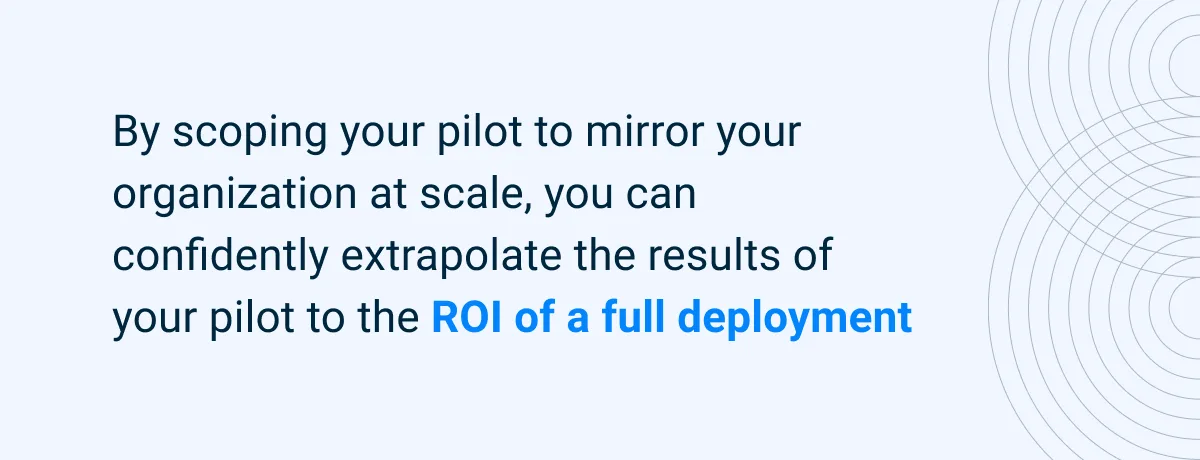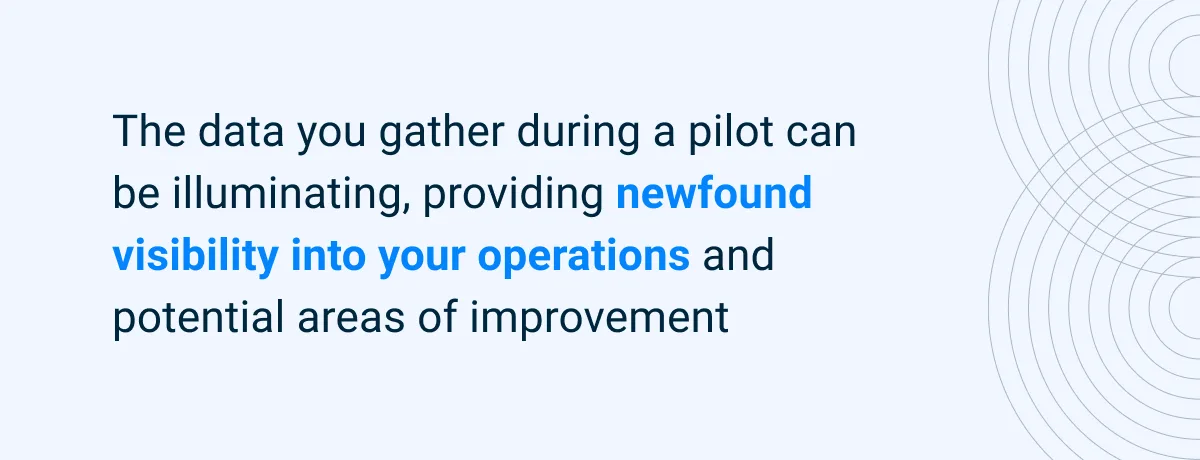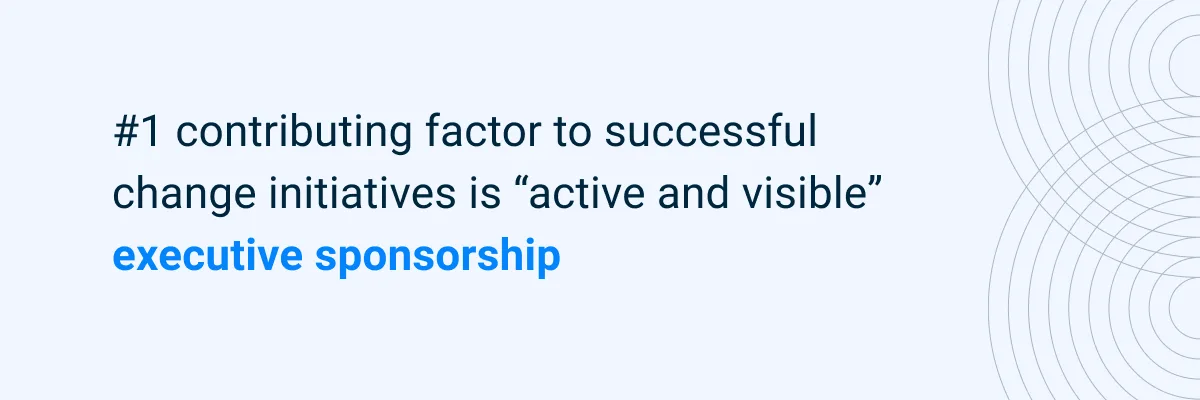Efficiency
7 Tips for a Successful Pilot: How Large Organizations Evaluate Samsara’s ROI
April 27, 2021

As a Business Value Manager at Samsara, I partner with some of the largest organizations in the country to help understand how Samsara can benefit their operations. Many of these organizations choose to conduct a pilot with Samsara before moving forward to a full deployment. A pilot is a great way to collect data specific to your organization, see how Samsara’s solutions can help solve your unique challenges, and estimate the ROI of a full deployment to make a highly-informed decision about our future partnership.
I’ve seen firsthand how beneficial a pilot can be, delivering concrete results such as an 80% decrease in safety events in just seven weeks. But I also understand concerns that a pilot will require significant time and resources for a large organization. Every pilot is unique, but we have seen certain best practices help large pilots run smoothly and efficiently. Ultimately, the time invested in these pilots pays off in spades.
If you are a leader at a large organization evaluating Samsara, keep reading to see our best practices for conducting a pilot that delivers meaningful results and helps you evaluate the long-term ROI of our partnership.
Executive summary
It’s important to scope your pilot to mirror your organization at scale. By selecting a data set that closely mirrors the characteristics of your entire organization, you can confidently extrapolate the results of your pilot to a full deployment.
For large organizations that plan to spend about two to three months overall on the pilot, the first month should be a data collection period. This can provide helpful insights for goal-setting, and you can measure Samsara’s ROI more accurately if you establish a baseline of your current performance first.
When setting goals for your pilot, pick success metrics that are measurable and good proxies for long-term ROI.
At the end of your pilot, include executive stakeholders in a live readout that summarizes your results and projected ROI. This is an effective and efficient way to provide executives with the data they need to make a confident decision about a full deployment.
1. Scope your pilot to mirror your organization at scale
Ultimately, the goal of any successful pilot is to understand what the potential impact of Samsara could be for your organization at scale. That’s why it’s important to select a data set that mirrors the characteristics of your entire organization. This way, you can confidently extrapolate the results of your pilot to a full deployment.
For example, for large organizations with thousands of vehicles or assets, a pilot should include between 20-40 vehicles or assets across multiple locations. The more closely your pilot data set mirrors your operations at scale, the better positioned you are to evaluate the metrics and features that will be meaningful to your organization. This way, you can make a confident, informed decision about moving forward to a full deployment.
Conversely, it can be overwhelming to run a pilot if the scope is too broad. For large organizations, most pilots take about two to three months. During this time, many of our customers successfully evaluate multiple Samsara products. Even if you are piloting multiple products, it can be helpful to identify your number one priority up front and start with that focus.

2. Before installing hardware, communicate transparently with employees
Transparent communication is key to any successful change management project. In fact, a Harvard Business Review report found that 70% of employees say they’re most engaged when senior leadership communicates openly about changes.
Consider your pilot a “mini implementation” that you can use as a test run, not only to evaluate the technology, but also to test your communication strategy and get feedback from employees. Communication helps everyone involved feel informed, engaged, and invested. It’s also a great way to create program advocates amongst front-line workers—a small group of employees respected by their peers who will champion your program moving forward.
Here are a few tips for successful pilot communications:
Be open and transparent: Provide visibility into management’s decision-making process. Highlight your high-level goals so that administrators and employees in the field understand the purpose of the pilot and feel aligned with the overall mission.
Explain how the technology works: Before you install any Samsara hardware, make sure to explain how the devices work, including what they can and cannot record and how they will be used.
Highlight the benefits: Help administrators and field employees understand how this new technology can benefit them. Explain how Samsara will affect their day-to-day activities.
3. Establish a baseline of your current performance
Once your hardware is installed, it may be tempting to immediately begin using Samsara’s various features. However, you can measure Samsara’s ROI more easily and accurately if you establish a baseline of your current performance first.
For large organizations that plan to spend two to three months on the pilot, the first month or so should be a data collection period. After four to six weeks of data collection, you will have a clear baseline of your current performance. The data you gather during this period can be illuminating—providing newfound visibility into your operations and potential areas of improvement, which may be surprising or different than what you thought before. You can also use the Samsara Fleet Benchmarks Report during this period to understand what is truly an area for improvement vs. what is already as good as or better than peers.
At the end of this benchmarking period, we often do a mid-pilot readout. This is helpful for identifying problem areas that can be focused on for improvement in the remainder of the pilot—the topic of our next tip.

4. Pick success metrics that are measurable and good proxies for long-term ROI
Goals are an important part of any successful pilot. However, choosing the right goals can be tricky. Organizations that run highly-effective pilots choose success metrics that meet two key criteria:
They can be measured and influenced meaningfully within the pilot time period.
They are good proxies for long-term ROI.
For example, if your goal is to increase safety and reduce costs associated with vehicle accidents, a good success metric would be a percentage decrease in safety events. It’s entirely possible that during your pilot, no accidents will occur. But safety events (like harsh braking, distracted driving, or tailgating) are smaller, more common incidents that you can meaningfully influence over a period of days or weeks. Furthermore, safety events are leading indicators of your ultimate goal—reduced accident risk—making them an excellent proxy for long-term ROI.
5. Proactively solicit feedback from administrators and employees in the field
During your pilot, qualitative feedback is just as important as quantitative metrics. That’s why it’s so important to proactively solicit feedback about Samsara from the administrators and field employees involved in your pilot.
This can help set up your program for long-term success by creating a tight feedback loop between administrators, employees in the field, and Samsara. Ultimately, customer feedback is what drives Samsara’s product development. Many of the large organizations we work with begin this feedback loop during their pilot and see it as key to our long-term partnership.

6. Quantify your results and build your business case
At the end of your pilot, evaluate your success metrics. What improvements did you see? How much improvement do you believe is possible in a full deployment? Extrapolating the improvements seen during your pilot across your entire organization can help you understand Samsara’s potential impact and ROI in the long term. For example:
Let’s say you achieved a 30% decrease in idling during your pilot. If that same reduction occurred across your entire fleet, how much fuel would you save annually? How much is that in monetary savings?
Alternatively, let’s say your goal is improving utilization, and during your pilot you discovered you had under-utilized assets. Now, you have the data you need to confidently rightsize your fleet. What does this save you on procurement costs? How much in additional earnings could you realize by putting those under-utilized assets to work?
7. At the end of your pilot, include executive stakeholders in a live readout
Research shows that number one contributing factor to successful change initiatives is “active and visible” executive sponsorship. That’s why we recommend including executive decision-makers in a live readout at the end of your pilot. This is a presentation that summarizes the results of your pilot, projected ROI, and your business case for a full deployment. It can be incredibly helpful for executives to understand that the business case is built upon data that was actually realized during the pilot.
Here are just a few results achieved by large organizations during pilots and presented to executives:
A global wholesale distributor decreased safety events by more than 90% over a seven-week period after beginning to use Samsara’s video-based driver coaching workflows.
After enabling in-cab audio alerts, a midwest electric and utility contractor saw a 58% decrease in harsh events and a 50% decrease in heavy and severe speeding (11 MPH or more over the speed limit).

Get in touch with our team about starting a pilot
Ultimately, a pilot is a great way to uncover new insights about your operations, understand Samsara’s potential ROI for your organization, and make a confident decision about our partnership.
No matter what your goals are, Samsara’s Connected Operations Platform can help you get there. But don’t take my word for it. To learn more about starting a pilot with Samsara, get in touch with our team today.
Start your pilot
















